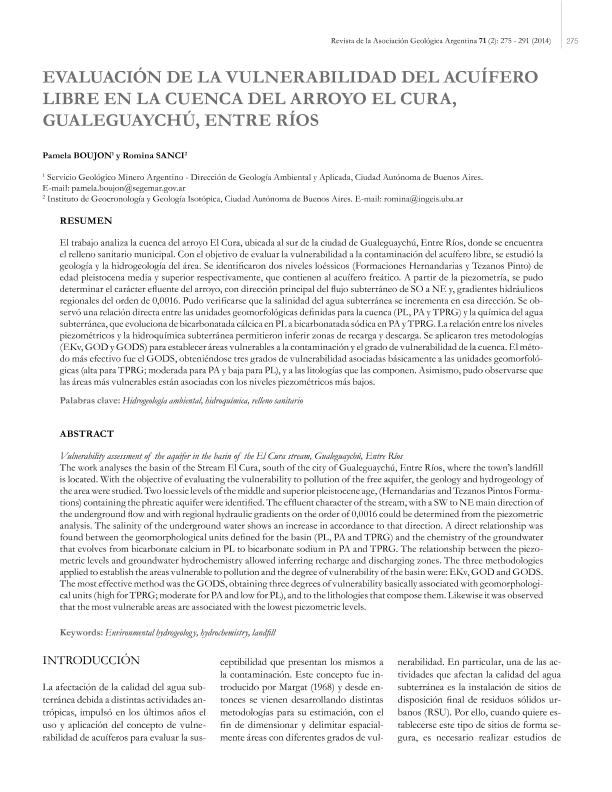Artículo
El trabajo analiza la cuenca del arroyo El Cura, ubicada al sur de la ciudad de Gualeguaychú, Entre Ríos, donde se encuentra el relleno sanitario municipal. Con el objetivo de evaluar la vulnerabilidad a la contaminación del acuífero libre, se estudió la geología y la hidrogeología del área. Se identificaron dos niveles loéssicos (Formaciones Hernandarias y Tezanos Pinto) de edad pleistocena media y superior respectivamente, que contienen al acuífero. A partir de la piezometría, se pudo determinar el carácter efluente del arroyo, con dirección principal del flujo subterráneo de SO a NE y, gradientes hidráulicos de 0,0016. Pudo verificarse que la salinidad del agua subterránea se incrementa en esa dirección. Se observó una relación directa entre las unidades geomorfológicas para la cuenca (PL, PA y TPRG) y la química del agua subterránea, que evoluciona de bicarbonatada cálcica en PL a bicarbonatada sódica en PA y TPRG. La relación entre los niveles piezométricos y la hidroquímica subterránea permitieron inferir de recarga y descarga. Se aplicaron tres metodologías (EKv, GOD y GODS) para establecer áreas vulnerables a la contaminación y el grado de vulnerabilidad de la cuenca. El método más efectivo fue el GODS, obteniéndose tres grados de vulnerabilidad asociados básicamente a las unidades geomorfológicas (alta para TPRG; moderada para PA y baja para PL), y a las litologías que las componen. Asimismo, pudo observarse que áreas más vulnerables están asociadas con los niveles piezométricos más bajos. The work analyses the basin of the Stream El Cura, south of the city of Gualeguaychú, Entre Ríos, where the town’s landfill is located. With the objective of evaluating the vulnerability to pollution of the free aquifer, the geology and hydrogeology of the area were studied. Two loessic levels of the middle and superior pleistocene age, (Hernandarias and Tezanos Pintos Formations) containing the phreatic aquifer were identified. The effluent character of the stream, with a SW to NE main direction of the underground flow and with regional hydraulic gradients on the order of 0,0016 could be determined from the piezometric analysis. The salinity of the underground water shows an increase in accordance to that direction. A direct relationship was found between the geomorphological units defined for the basin (PL, PA and TPRG) and the chemistry of the groundwater that evolves from bicarbonate calcium in PL to bicarbonate sodium in PA and TPRG. The relationship between the piezometric levels and groundwater hydrochemistry allowed inferring recharge and discharging zones. The three methodologies applied to establish the areas vulnerable to pollution and the degree of vulnerability of the basin were: EKv, GOD and GODS. The most effective method was the GODS, obtaining three degrees of vulnerability basically associated with geomorphological units (high for TPRG; moderate for PA and low for PL), and to the lithologies that compose them. Likewise it was observed that the most vulnerable areas are associated with the lowest piezometric levels.
Evaluación de la vulnerabilidad del acuífero libre en la cuenca del Arroyo El Cura, Gualeguaychú, Entre Ríos
Título:
Vulnerability assessment of the aquifer in the basin of the El Cura stream, Gualeguaychú, Entre Ríos
Fecha de publicación:
04/2014
Editorial:
Asociación Geológica Argentina
Revista:
Revista de la Asociación Geológica Argentina
ISSN:
1851-8249
Idioma:
Español
Tipo de recurso:
Artículo publicado
Clasificación temática:
Resumen
Palabras clave:
hidrogeología ambiental
,
hidroquímica
,
relleno sanitario
Archivos asociados
Licencia
Identificadores
Colecciones
Articulos(INGEIS)
Articulos de INST.DE GEOCRONOLOGIA Y GEOLOGIA ISOTOPICA (I)
Articulos de INST.DE GEOCRONOLOGIA Y GEOLOGIA ISOTOPICA (I)
Citación
Boujon, Pamela S.; Sanci, Romina; Evaluación de la vulnerabilidad del acuífero libre en la cuenca del Arroyo El Cura, Gualeguaychú, Entre Ríos; Asociación Geológica Argentina; Revista de la Asociación Geológica Argentina; 71; 2; 4-2014; 275-291
Compartir




